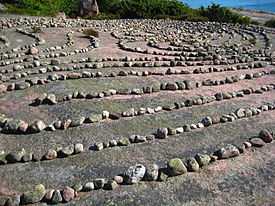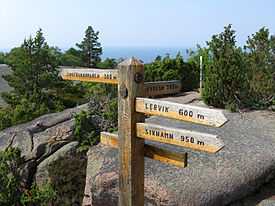Blå Jungfrun
| Blå Jungfrun National Park | |
|---|---|
|
IUCN category II (national park) | |
 | |
| Location | Kalmar County, Sweden |
| Nearest city | Oskarshamn |
| Coordinates | 57°16′N 16°47′E / 57.267°N 16.783°ECoordinates: 57°16′N 16°47′E / 57.267°N 16.783°E |
| Area | 1.98 km2 (0.76 sq mi)[1] |
| Established | 1926, extended 1988[1] |
| Visitors | 9,700 (in 1976) |
| Governing body | Naturvårdsverket |
| Website | Swedish Environmental Protection Agency |

Blå Jungfrun, or "Blåkulla", is a Swedish island in the Baltic Sea. More precisely, it is situated in Kalmar Strait, between the provinces Småland and Öland. Administratively, it belongs to the municipality Oskarshamn. It is uninhabited and has an area of only about 0.7 km², though it rises 86 metres above sea level. Since 1926, it is one of the national parks of Sweden. As a national park, there are important limitations to the Everyman's right at Blå Jungfrun. For example, you are not allowed to make up a fire or spend the night on the island.
The island consists partly of bare rock, partly of dense hardwood forest. The black guillemot is a characteristic bird. There are several caves and an ancient stone labyrinth.


Mythology
The island plays an important role in Swedish folklore, where it is viewed as an evil and magical place. The name Blå Jungfrun (Blue Virgin) was originally used by sailors to avoid provoking the evil spirits who dwelt on the island. According to a widespread belief, related already by Olaus Magnus in 1555, witches meet there each Maundy Thursday. Carolus Linnaeus, who visited the island in 1741, was sceptical:
- ... women and fairy-tales ... generally say that all witches will go here (truly a rather difficult journey) each Maundy Thursday; but those who have visited the place once are not likely to return, and should find out the reason for the fable: If any place in the world looks hideous, this is surely one of the most cruel...
According to a still living tradition, anyone who removes a stone from the island will suffer from bad luck until it is returned. Oskarshamn yearly receives stone shipments from people, often with an accompanying letter of warning describing the misfortunes and disasters which happened to them after removing a stone.
Park establishment
Between 1904-1925 the red granite of Blå Jungfrun was extracted in three quarries on the south of the island. It was exported chiefly to Germany as decorative stone. The destruction led to efforts to protect the island. A donation from the Swedish entrepreneur Torsten Kreuger made it possible to acquire the island and stop the quarrying. The national park was established on February 5, 1926 by the Swedish Government.[2]
Tourism
In summer, the island can be visited by tour boats from Oskarshamn or from Byxelkrok.[3] Regular trips began in the 1950s. A park guide on Blå Jungfrun informs the visitors about the national park and its regulations. The visit on the island lasts for about 3,5 hours.
See also
References
- ↑ 1.0 1.1 "Blå Jungfrun National Park". Naturvårdsverket. Retrieved 2013-05-23.
- ↑ Länsstyrelsen Kalmar - Blå Jungfrun.
- ↑ Solkustturer Boat to Blå Jungfrun
External links
| Wikimedia Commons has media related to Blå Jungfrun. |
- Blå Jungfrun National Park from the Swedish Environmental Protection Agency
- Blå Jungfrun.info - Website with information about Blå Jungfrun.